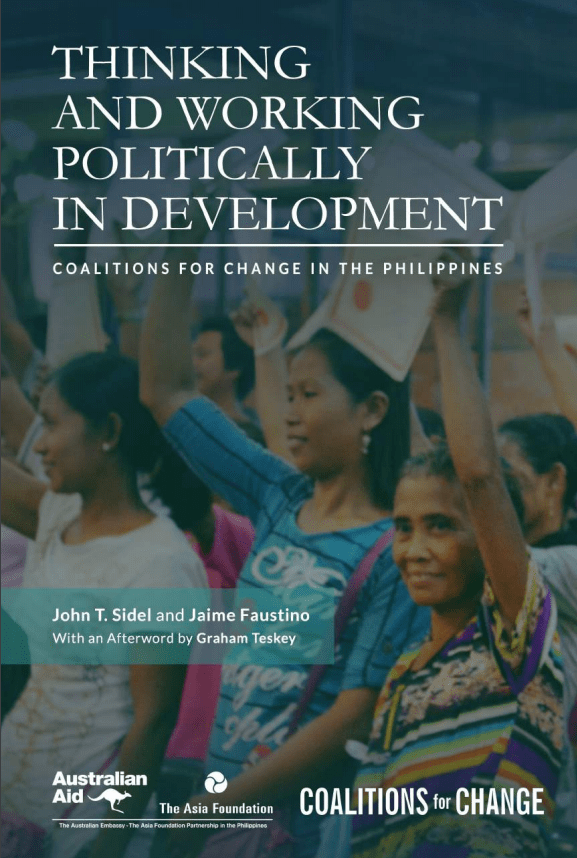By Graham Teskey
A remarkable book has just been published written by two remarkable blokes about a remarkable program. The book tells the story of an Australian-funded institutional reform initiative in the Philippines that did development differently well before the geeks at Harvard (sorry Matt) invented the term. The book is called “Thinking and Working Politically in Development: Coalitions for Change in the Philippines” here.

The two blokes are Jaime Faustino and John Sidel. Jaime was – and still is – the program leader working for The Asia Foundation in Manila, and John Sidel was – and still is – the ‘critical friend’ brought in to the program periodically to challenge, to question, to cajole, and sometimes even to support project selection, design and delivery. John used to be the Sir Patrick Gillam Chair in International and Comparative Politics in the London School of Economics and is now working with both the Departments of Government and International relations.
Formally, the Coalitions for Change program began its life in 2012. But its genesis can be found almost 20 years earlier, when Faustino worked as program officer at The Asia Foundation. He was a grants manager. He quickly realised that once any grant is given, there is little that the donor can do to change the strategies of the project. Faustino also realised that in general, grants to Civil Society Organizations (CSO) were focused more on participatory processes rather than on development outcomes. Grants seemed to enable “good people talking to other good people about doing good things”. In order to get more focus on Outcomes, Faustino sought tried to establish networks of relationships where the leaders could articulate what they really wanted to do. To get to a position where there was no need to “pretend” their agenda fit with the Foundation’s (Faustino’s words!). In some ways therefore the model developed as a reaction to a weak negotiating position: the approach was to build trust and a shared understanding and vision.
Faustino left to do other things outside of the Philippines but returned to the Foundation in 2006. At that time USAID was the main funder, and it is these years where the approach was honed and the term ‘development entrepreneurship; was born.
In 2011 Coalitions for Change was being designed by AusAID when a couple of entrepreneurial and far-sighted staff in the Australian Embassy considered shifting the focus from a process-oriented civil society development program to the more outcome-oriented program. In 2012, Coalitions for Change was launched, and Faustino joined the program, bringing his experience, vision and understanding with him. Up to then, Faustino had (in his own words) been ‘noodling around’ looking for local leaders to tackle national policy blockages that, with sufficient support, mobilisation, and action, could be challenged and possibly reformed. A range of issues was identified, following which a number of ‘small bets’ were made by the Embassy (although of course they were not so-called). A program then emerged, rather than being designed:
- budgets for each policy reform initiative were modest
- initiatives involved small teams of only Filipinos
- initiatives adopted a long-term perspective
- no results (the Outputs, Outcomes, and Impacts so beloved of donors) were promised or even identified in advance
- it was accepted that some initiatives would take on powerful vested interests, and some would take on seriously powerful vested interests
- AusAID kept well out of the way
- some initiatives got nowhere for years and were eventually dropped
- some initiatives got nowhere for years and then took off with spectacular results
At the very start, Adrian Leftwich from the Development Leadership Program suggested the importance of independently documenting and analysing the project. This became what was called ‘action research’ and it is how John Sidel got involved. The book tells the story of some of those spectacular successes as well as the less-spectacular failures. Over eight chapters it tells the story of what it means to do development different and what thinking and working politically means in practice.
I was asked to write an Afterword to the book – see Chapter Nine. The Afterword asks whether or not the model of CfC is replicable. I gave a rather depressing answer. I identified seven factors which all need to be in place for the successful adoption of the model. If one is missing the model is likely to fail.

The book and the Afterword were all completed in 2017. I leave it to the reader to infer the causes for the delay in publication. I was asked the other day if I am more optimistic three years later. The answer is sadly no. Criterion number 4 seems to be an even greater impediment than I thought at the time. The issues discussed here go to the heart of the debate about adaptive management (see here, here and here).
I would dearly love to be proved wrong.
But read the book. It blows out of the water any argument that development assistance is doomed to be ineffective.
